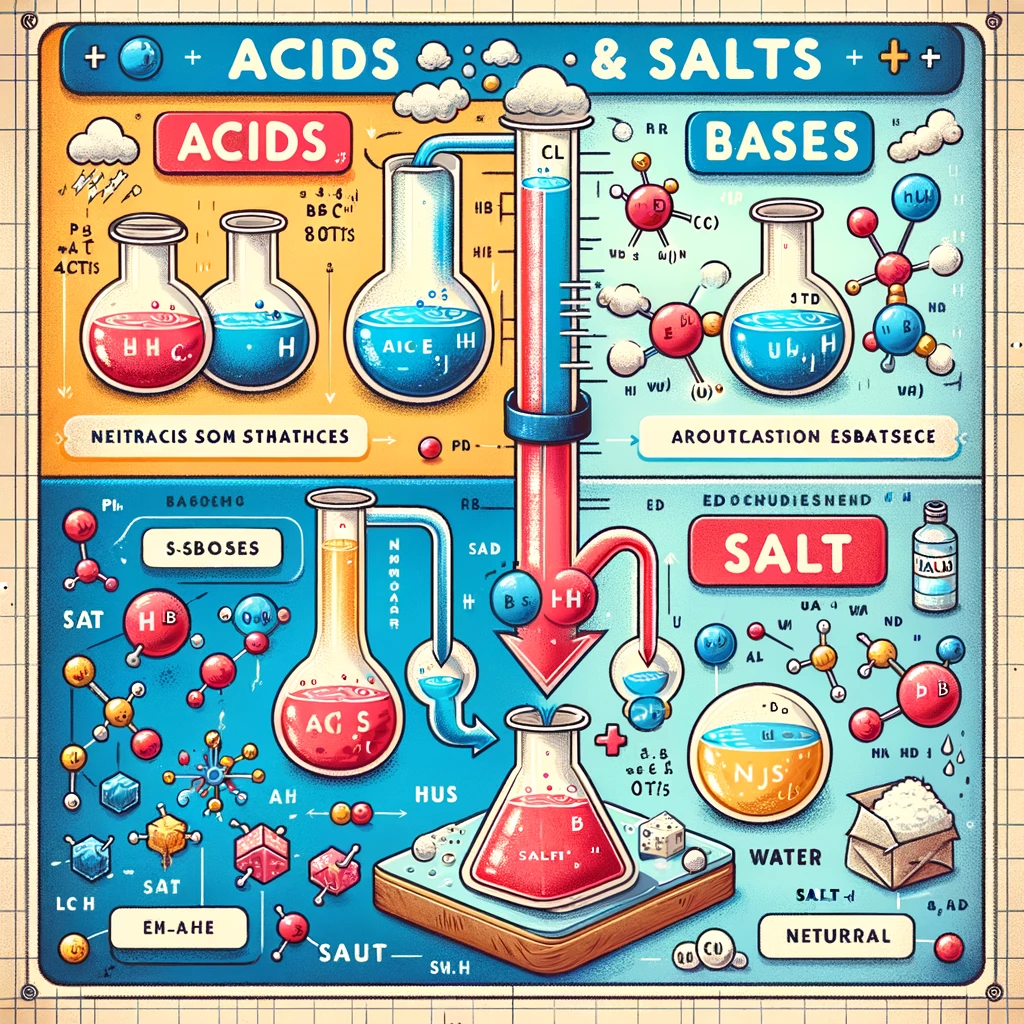
Comprehensive Exploration of Acids, Bases, and Salts for Class 10 Science Enthusiasts

The Intricacies of Acids, Bases, and Salts
Introduction
Acids, bases, and salts are cornerstone concepts in chemistry, each playing a crucial role in both the natural world and human-made environments. This chapter unveils the fascinating characteristics of these substances, their interactions, and their significance in various processes and products.
Section 1: Dive into Acids and Bases
Acids and bases are two classes of compounds that, when dissolved in water, release hydrogen ions (H⁺) and hydroxide ions (OH⁻), respectively. Their nature and strength are often measured using the pH scale, which ranges from 0 (strongly acidic) to 14 (strongly basic), with 7 being neutral.
Properties of Acids
- Taste and Texture: Acids have a sour taste and can be corrosive.
- Reactivity: They react strongly with metals, producing hydrogen gas and salts.
- Indicator Reactions: Acids turn blue litmus paper red and are neutralized by bases to produce water and salts.
Properties of Bases
- Taste and Texture: Bases are bitter and slippery to the touch.
- Reactivity: They react with acids in a neutralization reaction and can corrode organic materials.
- Indicator Reactions: Bases turn red litmus paper blue and change the color of other indicators, such as phenolphthalein, to pink.
Section 2: Neutralization and Salts
The reaction between an acid and a base, known as neutralization, results in the formation of water and a salt. Salts are ionic compounds that can be formed by replacing one or more hydrogen ions of an acid with a metal or another positive ion.
Types of Salts
- Neutral Salts: Formed by the complete neutralization of an acid with a base.
- Acid Salts: Result when a base incompletely neutralizes an acid, leaving some hydrogen ions unreacted.
- Basic Salts: Produced when an acid incompletely neutralizes a base, leaving some hydroxide ions unreacted.
Section 3: Applications and Importance
Acids, bases, and salts are ubiquitous in our daily lives, essential in numerous industrial processes, and pivotal in environmental phenomena.
Acids in Daily Life
- Citric Acid: Found in citrus fruits, used in foods and as a natural cleaning agent.
- Sulfuric Acid: Used in battery acid and in the manufacture of fertilizers.
Bases in Daily Life
- Sodium Hydroxide (Lye): Used in soap making and as a drain cleaner.
- Magnesium Hydroxide: Found in antacids to neutralize stomach acid.
Salts in Daily Life
- Sodium Chloride (Table Salt): Essential for human consumption and used in food preservation.
- Calcium Carbonate: Used in antacid tablets and in the manufacture of cement and lime.
Conclusion
Understanding acids, bases, and salts offers insights into the chemical foundations of the world around us. Their study not only enriches our knowledge of chemistry but also illuminates their practical applications in everyday life and industrial processes.
Call to Action
Engage with these concepts through experimentation. Test the pH of various household substances, observe the neutralization process, and explore the diverse uses of salts in your environment.